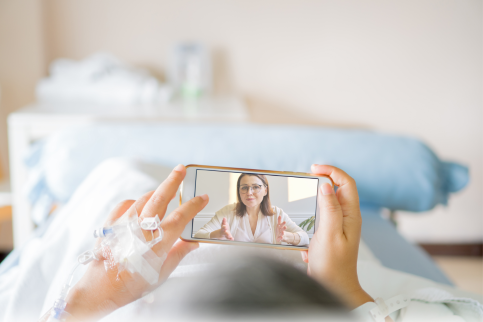Benefits of Telehealth Expansion in Psychiatry
Before the pandemic, many experts argued that telehealth would harm the patient-provider relationship so crucial in psychiatric care. For the most part, these fears have proved unfounded. It’s true that an online encounter sacrifices a certain degree of connectivity. Telepsychiatrists can’t offer perfect eye contact. However, the trade-offs are probably worth it. Getting 90% of a visit is better than no visit. (Which, alarmingly, is what 40% of people with serious psychiatric conditions were getting in the pre-pandemic era.)
On another positive note, the telepsychiatry boom has turned the old provider-centric paradigm on its head. Patients no longer need to schedule 90 days out and drive across town for routine care. Instead, they can access check-ups, medication adjustments, and counseling from their homes and workplaces. Many people don’t have the luxury of taking a half-day off of work to drive to an appointment, sit in a waiting room, and share physical space with a doctor so a treatment plan can be continued. It’s expensive and unnecessary. Over time, this could improve healthcare equity for lower-income workers, caregivers, rural and disabled patients, and others who have difficulty making in-person visits.
Other examples of telepsychiatry helping patients:
- Maintenance. Regular teletherapy sessions can help patients better manage their mental health and substance use conditions and avoid exacerbations.
- Better safety net. When a crisis does occur, patients can receive expert and timely treatment in the ED. Instead of waiting hours or days for inpatient admission, many ED patients can now be discharged home.
- Expanded services. Psychiatrists can virtually staff crisis stabilization units, which offer stable patients an alternative to the ED.
- Better treatments for substance use disorders. Telepsychiatry improves access to evidence-based therapies for people with opioid use disorder, like Medication-Assisted Treatment (MAT).
Beyond treating individuals, stakeholders are also using telepsychiatry to improve public health. A recent example is California Law 3242, which allows patients brought to the emergency room on involuntary psychiatric holds to be evaluated virtually. When appropriate, the telepsychiatrist can release the hold without seeing the patient in person. Telemedicine is face to face, so the encounter can be used to make decisions about voluntary or involuntary status. This policy change should result in drastically shorter wait times for this population.
Health systems and providers also benefit from telepsychiatry. On the hospital side, on-demand telepsychiatry consults help to ease emergency room crowding and improve patient flow. Because patients are evaluated quickly, they are less likely to become aggressive or disruptive. Most importantly, providers report an increase in morale, knowing they can deliver compassionate care that truly helps and heals.
The Future State of Telepsychiatry
As I noted above, our current healthcare system does a poor job managing chronic conditions—psychiatric and otherwise. In my opinion, this will represent the growing edge for telepsychiatry over the next five years.
Telepsychiatry allows us to evolve toward new, more synchronous models of team-based care. Under this paradigm, psychiatrists provide less clinical care and more consultation and coordination. On a regular basis—maybe every 90 days—the team will meet virtually with the patient to share updates and next steps from the care plan. This model allows the patient to be part of decisions and take a more active role in their healing.
Carried to its full potential, telepsychiatry could eventually integrate with team-based care for all chronic conditions. For example, a patient with heart disease would benefit from behavior change support to start a healthy diet. And if there’s an underlying condition like depression that drives unhealthy eating habits, it could be treated concurrently. Such a model requires us to build cultures that treat behavioral health as health and remove the stigma associated with mental healthcare.
Granted, it will take time and advocacy to bring this new paradigm to fruition. First and foremost, we need to advocate for reimbursement structures that incentivize teamwork over fragmentation. As healthcare leaders, we must also weave teamwork into the cultural fabric of our organizations. The best way to start is to focus both providers and payers on what’s best for the patient.
While telepsychiatry has grown exponentially over the past year, we’ve barely scratched the surface of its possibilities. At Vituity, we are committed to innovating acute psychiatric care for the benefit of patients everywhere. Our integrated solutions offer many paths to healing, from intensive inpatient care to short-term stabilization and patient navigation. Our approach integrates in-person and virtual care to ensure patients’ access to treatment where and when they need it.
At Vituity, we lead the industry to a future state that accepts behavioral health as a crucial component of overall wellness. By leveraging new care delivery models, health systems can make meaningful strides toward mental health parity and improve the lives of our most vulnerable patients.
Read more about how Vituity is transforming acute behavioral healthcare through telepsychiatry solutions.
























